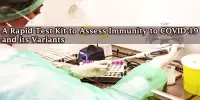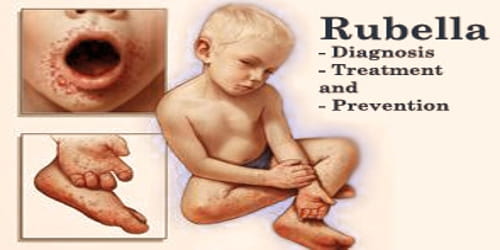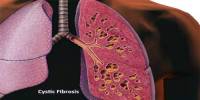Kernicterus
Definition
Kernicterus is also called nuclear jaundice. It is a disorder that is due to severe jaundice in the newborn, with deposition of the pigment bilirubin in the brain that causes damage to the brain, potentially leading to athetoid cerebral palsy, hearing loss, vision problems, or mental retardation, which is also known as bilirubin encephalopathy.
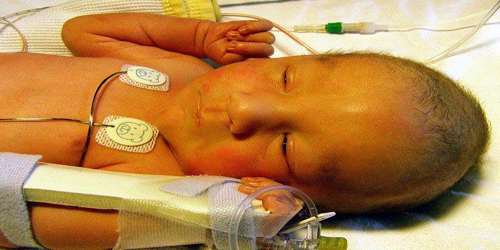
Bilirubin is a naturally occurring substance in the body of humans and many other animals, but it is neurotoxic when its concentration in the blood is too high, a condition known as hyperbilirubinemia. Hyperbilirubinemia may cause bilirubin to accumulate in the grey matter of the central nervous system, potentially causing irreversible neurological damage. Depending on the level of exposure, the effects range from clinically unnoticeable to severe brain damage and even death.
It’s normal for newborns to have high bilirubin levels. This is known as newborn jaundice. About 60 percent of babies have jaundice; because their bodies can’t remove bilirubin as well as they should yet. Kernicterus is much rarer. It involves dangerously high bilirubin levels. Kernicterus may be prevented by treating jaundice early before it gets severe.
Kernicterus risk factors –
- Were born prematurely. When babies are born before 37 weeks, their livers are even less well developed and will take longer to effectively remove bilirubin.
- Don’t feed well. Bilirubin is removed in stool. Poor feeding prevents babies from making enough dirty diapers.
- Have a parent or sibling who had jaundice as an infant. This condition can run in families. It may be linked to certain inherited disorders, such as G6PD deficiency, which causes red blood cells to break down too early.
- Were born to a mother with type O or Rh-negative blood type. Moms with these blood types sometimes give birth to babies who have high bilirubin levels.
Causes, sign and Symptoms of Kernicterus
Kernicterus is caused by severe jaundice that isn’t treated. Jaundice is a common problem in newborns. It happens because a newborn’s liver can’t process bilirubin quickly enough. Bilirubin builds up in the baby’s bloodstream as a result.
There are two types of bilirubin in the body:
- Unconjugated Bilirubin: This type of bilirubin travels from our bloodstream to our liver. It’s not water-soluble, meaning it doesn’t dissolve in water, so it can build up in our body’s tissues.
- Conjugated Bilirubin: This is converted from unconjugated bilirubin in our liver. Conjugated bilirubin is water-soluble, so it can be removed from our body through our intestines.
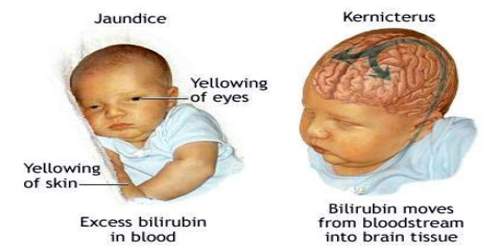
Bilirubin is known to accumulate in the gray matter of neurological tissue where it exerts direct neurotoxic effects. It appears that its neurotoxicity is due to mass-destruction of neurons by apoptosis and necrosis.
The early symptoms that a baby may display are jaundice, sleepiness, poor sucking, decreased muscle tone and absent reflexes. Mid-stage symptoms may include a bulging soft spot on their head, a high pitch cry, hyper flexed muscle tone, and seizures. End stage symptoms may be delays in learning and intelligence, seizures, muscle spasms or rigidity, and speech and hearing deficits.
Diagnosis, Treatment and Preventions of Kernicterus
Kernicterus is most often diagnosed in babies. One test that may be used to check bilirubin levels is a light meter. A doctor or nurse will check new born baby’s bilirubin levels by placing the light meter on baby’s head. The light meter tells how much bilirubin is in baby’s skin, or their transcutaneous bilirubin (TcB) level. If any baby’s TcB level is high, it could be an indication that bilirubin is building up in their body. Doctor will then order a bilirubin blood test.
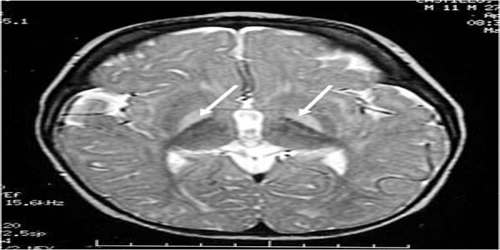
Quick treatment may help prevent further brain damage. Treatment may start with light therapy and fluids given through a needle into a vein (intravenous fluid replacement). Sometimes a baby may also have a tube placed down his or her throat or into the stomach for feeding with a special type of formula. Long-term treatment for brain damage will depend on a child’s specific problems. Typical treatment includes physical therapy, speech therapy, and special education.
The only effective way at preventing kernicterus is to lower the serum bilirubin levels either by phototherapy or exchange transfusion. Visual inspection is never sufficient; therefore, it is best to use a bilimeter or blood test to determine a baby’s risk for developing kernicterus. These numbers can then be plotted on the Bhutani nomogram.
Reference:

